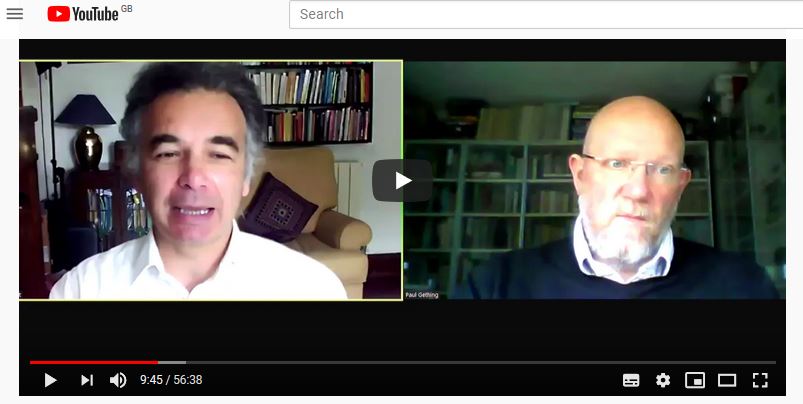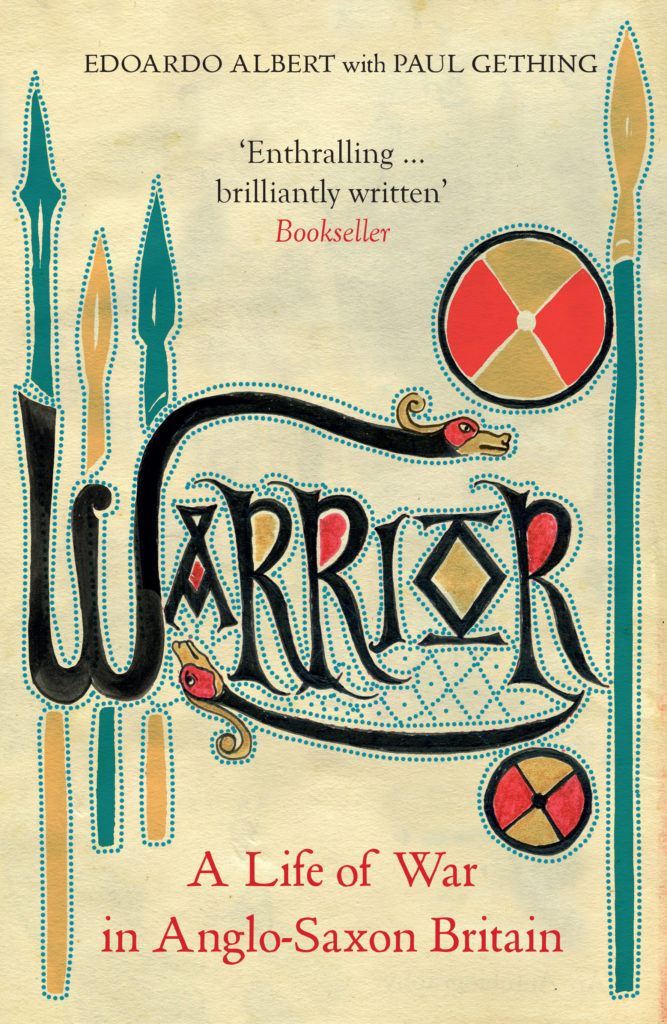Paul Gething and I will be talking ‘Warrior’ and all things archaeological and Anglo-Saxon at an online talk for the Felixstowe Book Festival at 1:30pm on Saturday 26 June. This will probably be the last time we talk about the warrior that Paul excavated from the Bowl Hole outside Bamburgh Castle, so if you want to hear about screaming skulls, Thor’s thunder and lots and lots of bones, get your tickets from the Festival box office. Here’s the link.
Warrior
YouTube Warriors

We’re on YouTube! The talk Paul and I gave about the Warrior and all things Anglo-Saxon is now up on YouTube so if you missed it you can see the whole thing here:
Webinar Q&A

There were many more questions than we had time to answer during our talk for the York Festival of Ideas. But luckily, we have all the questions that were submitted during the webinar and here are the answers!
Warrior: A life of war in Anglo-Saxon Britain – Saturday 7 June 2020, 1.00pm
York Festival of Ideas 2020 Online
Audience Questions, captured from the Zoom Webinar:
Stan Tan 01:25 PM
Hello from Singapore!
What is a “Bowl Hole” / why is the “Bowl Hole” termed as such?
Answer: Because it is a bowl shape: a depression amid the surrounding sand dunes.
Geoff 01:25 PM
Would the bodies buried face down with legs raised maybe infer a disposal rather than a burial?
Answer: we go into this in some detail in the book but in short, there are two explanations advanced for this type of burial: that it’s a sign of the person buried being in some form of disgrace or that, with the bloating that occurs in dead bodies and the corpse being put into the grave simply wrapped in a shroud, that it can be impossible for the burial party to know which way up they were burying the body.
Jack 01:37 PM
Given the classification of “warrior” to the finds and the idea they are elites are there any traces of this in their skeleton? healed broken bones or sign of a violent death etc?
Answer: Yes, there are. We go into this in detail in the book, but some of the skeletons show clear evidence of a very violent death: I am thinking in particular of one body where the skeleton was basically cut diagonally in half, from shoulder to waist.
Beverley Hallam 01:47 PM
What evidence can be gleaned about diet?
Answer: both direct and indirect. Remains of various foods have been excavated at Bamburgh, indicating a protein-rich diet with much meat eaten and various exotic imported foodstuffs, ranging from wild crane to lentils. The bones of the people excavated are uniformly free of the stress marks that indicate periods of starvation, so they were a well-fed and wealthy elite. Among the men, there is more evidence of tooth decay than among the women, which may be the result of drinking lots of sweet, and very alcoholic, mead.
Chris U 01:49 PM
Was there any evidence of cause of death on any of the skeletons?
Answer: there are some skeletons with clear evidence that they died violently, including one unfortunate man who was cut diagonally in half, from shoulder to waist.
Ruth 01:21 PM
Don’t forget the story of Grace Darling too. Women of the North East ….. strong women!
Answer: Indeed! There is an excellent Grace Darling Museum in the village.
Anonymous Attendee 01:25 PM
Why is it called the Bowl Hole?
Answer: because it’s shaped like a bowl!
Raffi Thomas 01:31 PM
Do you know if the broad axe was found in the same context as the sword? I’d be interested if they belonged to the same individual.
Answer from Paul: In the same garage, yes 😉 Until the archives are fully analysed and published I suspect this is uncertain.
henselmd 01:46 PM
Did you find a workshop at Bamburgh or implications of one–or are the artifacts thought to be spoils of war/raids?
Answer: There is some evidence for a smithy over towards St Oswald’s Gate.
S 01:46 PM
Did you find any female burials? If not, where would the women have been buried?
Answer: Yes, there were many female burials.
Sue Cumberpatch 01:47 PM
Is the book a fictionlised recreation, or a factual account?
Answer: the book is a factual account of the archaeology and history of Northumbria and the life and times of the Warrior: to bring this to life, I also interweave episodes in the Warrior’s life written with the techniques of historical fiction but always alive to the reality of the history and archaeology.
Lesley Hagon 01:47 PM
Can you talk more about the technology of the sword making – and is this a craft that died out?4
Answer: We’d need a whole book to do that – and we’re hoping to write one next, on how to make the perfect sword.
Anonymous Attendee 01:47 PM
The materials used particularly on the sword furniture are not local so where did these come from and so what does this say about the kind of trading relationships that these people had?
Answer: it tells us that trade links were much wider, and further reaching, than might be supposed for the time. For instance, some of the garnets used in Anglo-Saxon jewellery came from as far away as Sri Lanka. These luxury items were probably traded through a succession of middlemen before fetching up on the coast of the North Sea.
Anonymous Attendee 01:51 PM
Hi Paul, thank you for the interesting sharing. May I ask how do archaeologists tell from skeletons that these people are well-fed?
Answer: bones have a growth pattern that in some way resembles the rings in the trunk of a tree. If the person suffered periods of famine, particularly when growing up, this is shown in the patterns of bone growth.
Paul Bernardi 01:19 PM
Has any evidence of the early Angle fortress ever been found? From the time of Ida and his wife Bebba? (appreciate i may be jumping the gun here!
Answer: Yes, there has. St Oswald’s Gate and the structures around it date from the seventh century, and the well in the castle was probably cut down through the rock at this time.
Alison Offer 01:38 PM
These warriors living in a parallel world – are they exclusively young – do they settle down if they survive – thinking of Cuthbert who seemed to have fought as a youth – would he be one of these warriors – do you see the warriors as a separate community (say like the monks) or is been a warrior a rite of passage for all elite men?
Answer: Not exclusively young, but fighting is a young man’s game, then and now. However, experienced warriors still had to be prepared to fight at need. Having proved themselves among the king’s retinue, the best of his warriors were probably granted land and became, in effect, the king’s local representative.
Simon Thomas 01:39 PM
What date was the layer in which the window glass was found?
Answer: seventh century.
Walter Van Opstal 01:42 PM
beautiful gate!
Anonymous Attendee 01:44 PM
Having visited Bamburgh many times over recent years I have to say the information boards about the project could do with updating and expanding! Can members of the public support the project in some way to facilitate updating the information boards?
Answer: any support is gratefully accepted! If you would like to help, please email graemeyoung@bamburghresearchproject.co.uk.
Ruth 01:45 PM
What is the connection with Bradford Kaims?
Answer: Bradford Kaims is about five miles from Bamburgh. The BRP is excavating an ancient (Mesolithic to the Iron Age) wetland site there. For more information about the finds, please see here: https://bamburghresearchproject.co.uk/index.php/bradford-kaims/
Danny 01:45 PM
Presumably there was a larger Anglo-Saxon settlement at Bamburgh at this time. Can you say something about that?
Answer: Not too much, archaeologically, as we haven’t excavated there. But certainly, historical sources suggest a settlement around the castle, and there was probably a beach market on the strand.
Valerie Coyne 01:46 PM
Any females amongst the burials?
Answer: Yes, and in particular a young Norwegian woman (early 20s) who died and was buried in the cemetery in the sixth century, long before the better known contacts between Britain and the Viking world.
Valerie Coyne 01:51 PM
thanks very informative
Answer: Thank you!
Nic 01:46 PM
Why do you think one of the skeletons was buried face down?
Answer: we go into this in some detail in the book but in short, there are two explanations advanced for this type of burial: that it’s a sign of the person buried being in some form of disgrace or that, with the bloating that occurs in dead bodies and the corpse being put into the grave simply wrapped in a shroud, that it can be impossible for the burial party to know which way up they were burying the body.
Susan Palmer 01:47 PM
Are you still excavating in Bamburgh?
Answer: Yes, and you can join in! The Bamburgh Research Project excavates each summer (although this summer’s dig is still up in the air for obvious reasons) and it’s open to members of the public interested in trying archaeology hands on. See here for more details: https://bamburghresearchproject.co.uk/index.php/archaeology-field-school-2/
Gavin Welch 01:47 PM
How long does it take to acquire a burial licence? And how do you secure such an important site for that time frame whilst you wait?
Answer: It’s all in the book! But the short answer is, a while. And the BRP secured the site by reburying the bodies while they waited for the licence to come through.
Anonymous Attendee 01:47 PM
Why were the swords so extravagantly decorated?
Answer: Wouldn’t you? These warriors lives depended upon their weapons, and the blades were things of beauty in themselves. Further, the wielder’s status would be enhanced by the sword’s accompanying ‘bling’.
Andrew Sefton 01:48 PM
Why were they buried away from the church, were they fully Christian?
Answer: while the earliest graves in the Bowl Hole date from the pre-Christian era, most of the people buried there would have been Christian. In the book, we suggest that the Bowl Hole cemetery was reserved for non-local people who died while in Northumbria, as many of the bodies show evidence of having been born and brought up elsewhere.
Rick Brookes 01:48 PM
Did all of the graves have the same orientation?
Answer: roughly, yes, towards the east and the sea.
Jan Garrill 01:50 PM
Are these people of a similar size in height and physical stature to modern man?
Answer: Yes. And probably much stronger.
Karl&Vicky 01:50 PM
Have any other examples of pattern welded blades been excavated eleswehere in the country? Are they specific to the Anglo-Saxon period?
Answer: Yes. The best known is the sword buried at Sutton Hoo but there have been others. Pattern-welded blades are not specific to this era, but the time and effort that went into making such a sword was best repaid at a time when armies were small (often less than a hundred men), rather than the much larger armies of the late Anglo-Saxon/early Norman era.
James Pennock 01:51 PM
The book is superb – the crossover of 2 different approaches to history works really well. What have you both taken away from the other? Can the other approach influence your own?
Answer: Thank you! That’s really kind of you. I think we were trying to do something different – dare I say, unique – with this book, hammering together different strands of narrative to make a whole that lights up the subject from different angles, rather like the way the garnets of the period were cut and polished.
Walter Van Opstal 01:53 PM
Do you know exactly where the sword was excavated from? r were the records lost in that garage?
Answer: We have a reasonable idea of the context of the swords.
Paola 01:54 PM
In terms of pathologies… was there any evidence of inter-personal trauma in the skeletons? Paul showed one skeleton buried prone which in Saxon times this is interpretated as possible ‘deviant’ and as such they’re likely to present some form of trauma…
Answer: yes, some of the skeletons did show very clear, indeed quite horrific, evidence of injury, in particular one unfortunate man who was sliced diagonally in half, from shoulder to waist.
Anonymous Attendee 01:54 PM
Where were the metal workers buried?
Answer: We don’t know.
Stan Tan 01:55 PM
Hello from Singapore!
How did the Indian or Japanese influences get imported?
Answer: There probably weren’t any Japanese influences, but some garnets did come from Sri Lanka, traded through middle men via the Middle East.
Barry 01:55 PM
Had most of these people died of natural causes or had they been killed?
Answer: You can only tell for certain a violent death if the skeleton was damaged (as happened with one man who was cut diagonally in half). Others may have died through blood loss or injury to internal organs without that leaving any trace on the body.
Raffi Thomas 01:55 PM
Do you think the Dalriadan would’ve been a Christian, and if so is this reflected in his burial?
Answer: Yes, we think the Warrior was a Christian. He has no grave goods, and the portion of the cemetery where he was buried has a number of other graves buried in a typical Dal Riadan fashion.
Helen Butt 01:58 PM
Thank you for such a fascinating talk. Can’t wait till I can visit….
Answer: You’re welcome! You should visit: Bamburgh and Northumberland are wonderful.
York Festival of Ideas

Paul Gething and I are talking Warrior and all things Anglo-Saxon at 1pm on Sunday 7 June @YorkFestofIdeas. It’s an online webinar so anyone can attend (and see what we look like after 10 weeks without haircuts!). Book tickets here: http://yorkfestivalofideas.com/2020-online/calendar/warrior-life/#yorkideas
Warrior – Out Now in Paperback

Warrior: A Life of War in Anglo-Saxon Britain is out now in paperback. The Bookseller called it ‘enthralling…brilliantly written‘. The Spectator said it ‘reveals the disruptive and imaginative force of archaeology‘. Find out what they mean, and how the bones of an anonymous warrior excavated near Bamburgh Castle in Northumberland can reveal the deep foundations of Britain. Get it from Amazon and other good booksellers.
Scaling the Literary Heights
Just how much more literary is it possible to get? I’ve written a feature for the Granta website. About the only things I can think of with more literary kudos would be writing something for the Granta magazine or winning the Booker Prize! The artice is called ‘Dem Bones, Dem Bones, Dem Dry Bones’ and you can read it here.

History Bro on Tour
The History Bros (in Law) temporarily split and this History Bro goes solo on Thursday 24 October at Haslemere Bookshop in, yes, Haslemere, talking Warrior and all things Anglo-Saxon. It’s the only stop on the Warrior tour in the south, so I hope you’ll be able to join me. The evening starts at 7.30pm and tickets are available direct from Haslemere Bookshop.

On The Road
Next stops on the History Bros (in Law) Warrior road tour are two book festivals this weekend in Galloway, Scotland, and Carlisle, England.

At 1.30pm on Saturday 5 October, Paul and I are appearing at the Wigtown Book Festival in, of course, Wigtown. Tickets available here.

Then at 3.30pm on Sunday 6 October we are at the Borderlines Festival in Carlisle. Tickets here.
Me, Interviewed
The lovely people at NF Reads interviewed me a little while back. Here are the results: https://www.nfreads.com/interview-with-author-edoardo-albert/
Best bit? Being completely stumped by the ‘what role do emotions play in creativity’ question.
Forum Books – Tour Day 1
The History Bros had the first stop on our Warrior book tour yesterday, at Forum Books in Corbridge, and it went better than we could have hoped. Every ticket was sold and the good people at Forum even had to get in some extra chairs to accommodate more people who turned up on the night. Forum Books itself is everything an independent bookshop should be and completely delightful – as you’ll see from the photos below. One of the audience, journalist Ian Wylie, very kindly forwarded me these photos he took of the event. Find more of his work on Twitter @ianwylie. Our next stops, on Saturday 5 October and Sunday 6 October, are the Wigtown Literary Festival in Wigtown and the Borderlines Festival in Carlisle. I hope to see you at one of these. In the meantime, here are Ian’s brilliant photos of Tour Day 1.






















